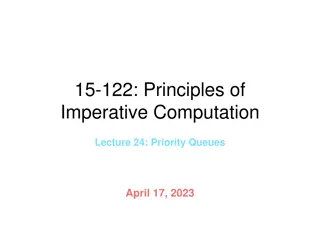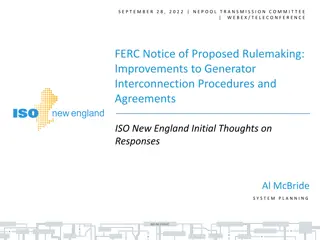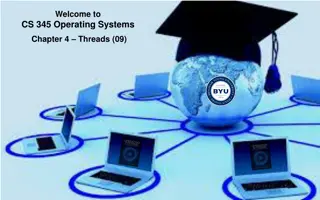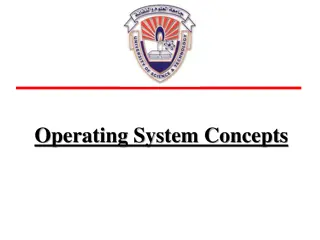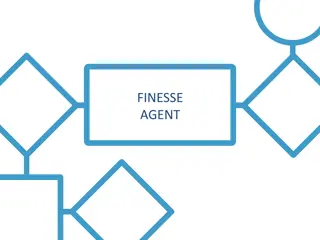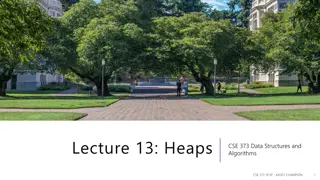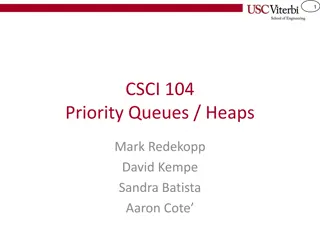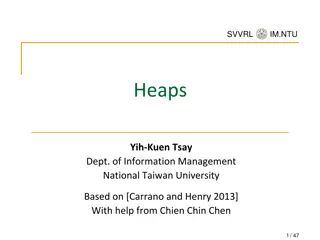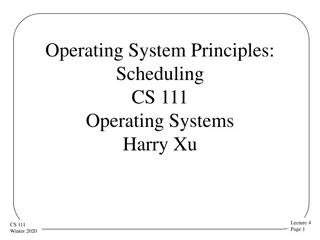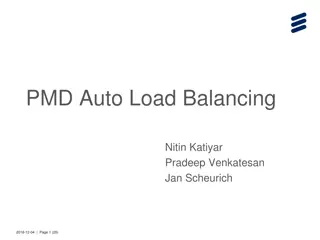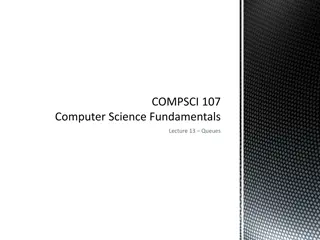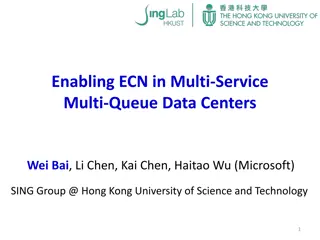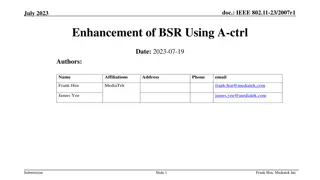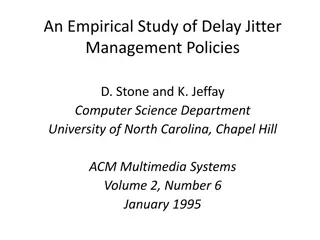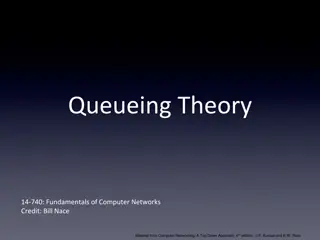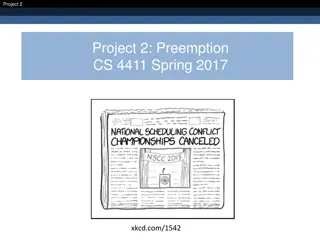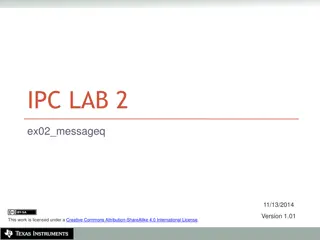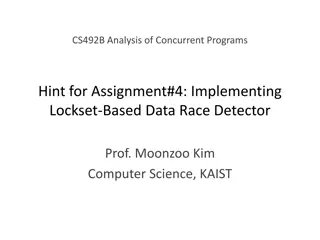15-122: Principles of Imperative Computation.
Explore the fundamentals of priority queues, including how they prioritize elements based on specific criteria, such as emergencies or deadlines. Learn about key operations like adding and retrieving elements, with examples from different real-world scenarios. Delve into creating a Priority Queue In
1 views • 45 slides
Moorfields Volunteers Initiative: Supporting the NHS with Dedicated Service
Volunteers at Moorfields, led by Angela Smith, have played a pivotal role in assisting the hospital's pandemic response and ongoing operations. The current volunteer roles encompass a wide range of responsibilities from queue management to providing clinic support. Notably, Theatre Support Volunteer
2 views • 12 slides
Federal Energy Regulatory Commission Transmission Update - Nov. 3, 2023
FERC, led by Director Rob Thormeyer, regulates natural gas wholesale facilities, interstate pipelines, onshore LNG facilities, wholesale electric market rates, and more. The Commission consists of five appointed Commissioners overseeing key initiatives like transmission planning proposals and interc
0 views • 14 slides
Improvements to Generator Interconnection Procedures: ISO New England Response
FERC's Notice of Proposed Rulemaking seeks to enhance generator interconnection procedures to address queue backlogs and promote fairness. ISO New England outlines expansive changes, including a first-ready, first-served process, and discusses trade-offs in project viability and completion expectati
0 views • 36 slides
Black Barrier Stand For Event Barrier Hire
Enhance event safety with our Black Barrier Stand. Perfect for crowd control\nand queue management. Available for hire. Order now for your next event.
1 views • 8 slides
Supply Analysis WG Update & Project Success Factor Analysis
The Supply Analysis Working Group provides updates on mid-term load forecasts using different weather models. The report highlights how weather unpredictability affects forecast accuracy. Additionally, the Planned Project Success Factor Analysis evaluates success rates and development cycle trends f
0 views • 13 slides
Understanding Queuing Theory and Its Applications in Operations Research
Queuing theory is a mathematical study of waiting lines, or queues, commonly applied in operations research to predict queue lengths and waiting times. It helps businesses make decisions regarding resource allocation for efficient service provision. This field also encompasses queue discipline and E
1 views • 10 slides
Understanding Lamport Algorithm for Mutual Exclusion
Lamport Algorithm, presented by Prafulla Santosh Patil, is a permission-based algorithm utilizing timestamps to order critical section requests and resolve conflicts. It employs three types of messages: REQUEST, REPLY, and RELEASE, where each site manages a queue to store requests. By ensuring commu
0 views • 15 slides
Understanding Threads and Task Scheduling in Operating Systems
Threads and task scheduling play a crucial role in modern operating systems. This chapter delves into the concept of threads, including standard integer typedefs and the importance of multitasking. It explores the implementation of a five-state task scheduler capable of executing multiple tasks effi
0 views • 25 slides
Understanding CPU Scheduling in Operating Systems
In a single-processor system, processes take turns running on the CPU. The goal of multiprogramming is to keep the CPU busy at all times. CPU scheduling relies on the alternating CPU and I/O burst cycles of processes. The CPU scheduler selects processes from the ready queue to execute when the CPU i
1 views • 26 slides
Finesse Agent and Supervisor User Guide
Learn how to use the Finesse Agent and Supervisor interface efficiently. Discover key features such as changing agent states, handling calls, transferring calls, and accessing queue statistics. Log in with your user ID and password to start managing calls and providing exceptional customer service.
0 views • 17 slides
Workshop on Fine-grained Measurements App with P4 Programmable Switches
Explore the world of P4 programmable switches in a workshop hosted by the University of South Carolina. Learn about P4, programmable data plane switches, packet parsing, queue monitoring, and applications with P4 switches. Discover the shift from traditional networking to SDN, overcoming limitations
1 views • 19 slides
Understanding the Non-Blocking Michael Scott Queue
The Non-Blocking Michael Scott Queue, presented by Gurudatta Patil, is a thread-based data structure where threads help each other in managing a queue efficiently. Threads collaborate to add nodes at the tail and remove them from the head, ensuring smooth operation even in a non-empty queue scenario
0 views • 17 slides
Procedures for Closing and Declaring Polls in an Election
Learn the steps involved in closing and declaring polls during an election, including distributing slips, closing the control unit, recording votes, sealing election papers, and delivering materials to the collection center. Follow guidelines for distributing numbered slips to voters present at clos
0 views • 38 slides
Understanding Priority Queues and Heaps in Java Collections
Explore the concepts of priority queues, heaps, and related data structures in Java Collections Framework. Learn about the Priority Queue class, Entry ADT, Comparator ADT, and Total Order Relations, along with their practical applications in process scheduling and more.
0 views • 44 slides
Understanding Heaps and Priority Queues in Data Structures
Exploring the concepts of heaps, priority queues, and the Priority Queue ADT in the context of data structures. Topics include the implementation of priority queues, comparing different data structures for efficiency, and the behavior of operations like insert and removeMin.
0 views • 40 slides
Understanding Priority Queues and Heaps in Data Structures
Priority queues prioritize item retrieval based on value, contrasting with traditional queues that follow a first-in-first-out approach. Priority queues efficiently manage items based on their importance, often utilized in scenarios like emergency rooms or air traffic control. Heaps, a form of binar
0 views • 20 slides
Understanding Priority Queues and Heaps
Priority queues differ from regular queues by maintaining an ordering of items based on priority rather than first-in-first-out. Items in a priority queue are assigned priority values and the highest priority item is removed first. Different data structures can be used to efficiently insert and remo
0 views • 54 slides
Understanding Binary Heaps: Efficient Data Structure for Priority Queue Operations
Explore the concept of binary heaps, a specialized type of binary tree that allows for quick retrieval of the smallest (or largest) element. Learn how binary heaps excel in finding the minimum value, essential for priority queue applications in operating systems, event simulations, and more. Compare
2 views • 34 slides
Implementing a Priority Queue with Heaps
Learn about implementing a priority queue using heaps. Priority queues are essential data structures that maintain a special ordering property. The use of binary trees and heaps is explained in detail, focusing on maintaining shape and heap properties during insertions.
0 views • 57 slides
Understanding Heaps: A Complete Binary Tree Data Structure
Introduction to heaps, a special type of complete binary tree used for efficient priority queue implementation and sorting. Explains the concept of maxheap and minheap, along with operations like isEmpty, getNumberOfNodes, getHeight, peekTop, add, and remove. Includes visual aids and definitions to
5 views • 47 slides
Understanding Priority Queues and Heap Data Structures
Priority queues play a key role in computer science algorithms by managing data based on priority levels. The use of heap data structures enhances the efficiency of priority queue operations. This tutorial covers the basics of priority queues, their applications, different implementations such as li
0 views • 30 slides
Priority Queues in Java: Implementation and Use Cases
Explore the concept of priority queues in Java, covering implementations using unsorted and sorted linked lists, as well as heaps. Learn about the differences between a queue and a priority queue through reading quizzes and discover various priority queue implementation options. Dive into priority q
1 views • 42 slides
Understanding Heap Sort and Binary Search Tree Concepts
Learn about Heap Sort for sorting elements in ascending or descending order, Priority Queue as a data structure supporting key operations, Binary Trees with recursive definitions, and exercises involving priority queue operations. Explore the concepts through visual aids and examples provided in the
0 views • 18 slides
Priority Queues: Operations and Implementations
Priority queues are data structures that allow efficient insertion, deletion, and retrieval of elements based on their priority. This information-rich content covers various aspects of priority queues, including ideal times, binomial queues, Dijkstra's algorithm for single-source shortest paths, and
0 views • 11 slides
Understanding Operating System Scheduling Principles
Operating system scheduling involves making decisions on resource allocation among multiple clients, determining who gets to use the resource next and for how long. Different scheduling algorithms aim to achieve specific goals, such as maximizing throughput, minimizing waiting time, ensuring fairnes
0 views • 57 slides
Understanding Priority Queues and Heaps in CSE 373 Lecture
Today's lecture in CSE 373 covers the Priority Queue Abstract Data Type (ADT), the properties of heaps, and their implementations. Key topics include the completeness property of heaps, different priority queue implementations such as the binary search tree for faster insert and find operations, and
0 views • 21 slides
Automatic Load Balancing Proposal for PMD Port Queue Assignment
This proposal discusses dynamic port queue assignment strategies for PMDs in network environments. It covers both static and dynamic assignment methods, such as round-robin and cycles-based algorithms, to ensure uniform load distribution. The proposal introduces an automatic load balancing feature,
0 views • 20 slides
Understanding Queues in Computer Science: Principles and Implementations
Explore the concept of queues in computer science, focusing on ordered collections of data following the FIFO principle. Learn about queue ADTs, implementations in Python, and delve into a simulation of a Printer Queue problem. Discover how to model printing tasks as random events and analyze the im
0 views • 15 slides
Enhancing Data Center Performance with ECN-Based Transports
This study focuses on enabling Explicit Congestion Notification (ECN) in multi-service, multi-queue data centers to cater to diverse network requirements. ECN-based transports like DCTCP and DCQCN achieve high throughput and low latency by allowing end-hosts to react to ECN signals and switches to p
0 views • 65 slides
Comprehensive Overview of Electronic Personnel Action Forms (ePAF) and Terminology
Delve into the world of Electronic Personnel Action Forms (ePAF) and the associated terminology such as Approval Categories, Queue Status, and more. Learn about the definitions and processes involved in managing human capital effectively.
0 views • 36 slides
Enhancement of Buffer Status Reporting in IEEE 802.11 - A Solution Proposal
This document proposes enhancements to the Buffer Status Reporting (BSR) mechanism in IEEE 802.11, particularly addressing the issue of inaccuracies in reporting queue sizes exceeding 2,147,328 octets within PPDU frames. The proposal suggests adding an additional field in the A-ctrl frame to accommo
0 views • 9 slides
An Empirical Study of Delay Jitter Management Policies
This study explores delay jitter management policies to support interactive audio over LANs, focusing on display queue management to minimize gaps in playout. The paper evaluates different queue management policies, including I-policy and E-policy, along with queue monitoring in the context of an em
0 views • 37 slides
Understanding Queueing Theory in Computer Networks
Queueing theory is a powerful analytic tool used to analyze performance in queueing processes, applicable in various industries including retail, manufacturing, and computer networks. It involves studying characteristics such as arrival patterns, service patterns, and queue disciplines to make perfo
0 views • 61 slides
Project 2: Preemption in CS 4411 - Spring 2017
Project 2 focuses on addressing issues of selfish threads, starvation, and interruption handling within multi-level feedback queue scheduling. The project introduces clock interrupts, alarms, interrupt handlers, and addresses the importance of performance optimization for handling shared data struct
0 views • 19 slides
Overview of Intel 8086 Microprocessor and Internal Architecture
Intel 8086 microprocessor is a vital component in electronics, with an internal architecture comprising BIU and EU. The BIU handles bus operations, instruction fetching, and address calculation, while the EU executes instructions from the instruction queue. The pin diagram and internal architecture
0 views • 19 slides
IPC Lab 2 MessageQ Client/Server Example
This MessageQ example demonstrates the client/server pattern using SYS/BIOS heap for message pool, anonymous message queue, and return address implementation. The example involves two processors - HOST and DSP, where the DSP processor acts as the server creating a named message queue, and the HOST p
0 views • 12 slides
New Queue Mechanism for Real-Time Application Considerations in July 2019
In July 2019, considerations were made for a new queue mechanism for real-time applications. The focus was on improving worst-case latency and jitter for latency-critical traffic, such as in online mobile gaming and manufacturing control. The proposed design aims to link access delay directly to req
0 views • 9 slides
Overview of Fall Semester 2019 HPC Current Report
The Fall Semester 2019 HPC Current Report highlights changes made in resource allocation, job queue management, utilization analysis, and factors influencing job priority. Key modifications include adjusting memory per CPU, implementing limit enforcement, and changing fairshare weights. The report d
0 views • 20 slides
Lockset-Based Data Race Detector Implementation
Learn how to implement a lockset-based data race detector in Java using concepts such as HashMap, LinkedList, stack, queue, and memory location states. Explore data structures for thread management, memory addresses, and memory monitoring for efficient detection of data races in concurrent programs.
0 views • 7 slides
